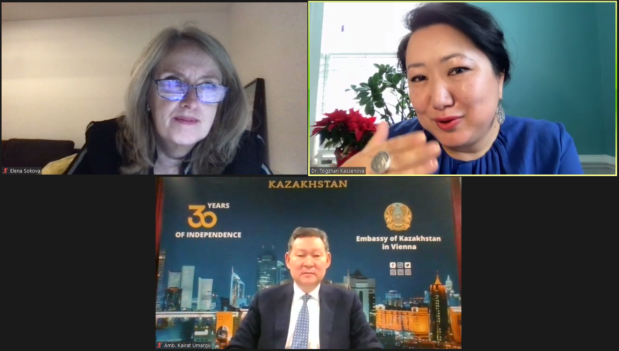
On 9 December 2021, the VCDNP held the webinar with Dr. Togzhan Kassenova about her new book “Atomic Steppe: How Kazakhstan Gave Up the Bomb.”
Dr. Togzhan Kassenova is a Senior Fellow with the Project on International Security, Commerce and Economic Statecraft at the Center for Policy Research, SUNY-Albany, and a Non-resident Fellow in the Nuclear Policy Program at the Carnegie Endowment for International Peace.
The event was moderated by VCDNP Executive Director Elena K. Sokova. In her opening remarks, she noted that with the growing international dialogue on nuclear issues, the story of how Kazakhstan gave up its nuclear inheritance holds important lessons for global security. She also noted how timely Dr. Kassenova’s book launch was – on the eve of Kazakhstan’s 30th anniversary of independence.
In this regard, the VCDNP was honoured that Permanent Representative of Kazakhstan to the United Nations in Vienna, Ambassador Kairat Umarov, joined the book launch with opening remarks. Ambassador Umarov said that Kazakhstan turned the challenges it faced as a new country with its multi-ethnic population, diverse religions and the Soviet legacy of nuclear infrastructure into an opportunity. For 30 years, Kazakhstan has been making the journey from the country with no footprint on the political map to a stable nation and respected member of the international community.

Beginning her remarks, Dr. Kassenova characterised “Atomic Steppe” as a journey that spans the forty-year period of Soviet nuclear tests at the Semipalatinsk testing site in Kazakhstan. The book reveals untold stories of those who built the site and the difficult conditions in which people worked. According to Dr. Kassenova, there were thousands of military construction workers, even prisoners, who toiled in at Semipalatinsk for two years while the site was under construction. As she discusses the consequences of nuclear tests on the environment and people in the book, she also narrates the story of the Nevada-Semipalatinsk international anti-nuclear movement.
Dr. Kassenova explained that, in her book, she narrates the story of Kazakhstan’s nuclear disarmament in three parts. The first part concludes with how Kazakhstan was able to shut down the nuclear test site while it was still part of the Soviet Union. In the second part of the book, she unveils events after the Soviet Union collapsed, mainly related to US-Kazakhstan nuclear diplomacy and negotiations on Kazakhstan’s accession to the Treaty on the Non‑Proliferation of Nuclear Weapons as a non-nuclear weapon State. She describes undisclosed operations and projects on removing nuclear material and dismantling nuclear weapons infrastructure. She also discusses the role of scientists and technical experts from Kazakhstan, Russia, and the United States who worked collaboratively on these essential projects.
The concluding chapter of the “Atomic Steppe” brings the reader back to today’s Kazakhstan, the challenges and opportunities the country faces, and the role of Kazakhstan’s nuclear diplomacy today.
Dr. Kassenova then discussed the reasons why she wrote the book, how Kazakhstan’s anti‑nuclear movement came about and why Kazakhstan chose a non-nuclear path. One of the reasons behind writing the book, according to Dr. Kassenova, was to tell the stories of real people and present them to the world and Kazakhstan’s own audience. Her goal was to illustrate Kazakhstan’s case to the nuclear policy world and show that nuclear weapons programmes involve real people rather than remaining something abstract. Regarding Kazakhstan’s anti-nuclear movement, Dr. Kassenova explained how the push for the closure of the Semipalatinsk nuclear test site was approached from various levels: locally in Semipalatinsk city under the leadership of Keshrim Boztaev; nationwide under the leadership of a famous Kazakh writer Olzhas Suleimenov who spearheaded the anti-nuclear movement; and at the level of government under the leadership of Nursultan Nazarbayev.
Addressing Kazakhstan’s strategic decision to take a non-nuclear path, in “Atomic Steppe,” Dr. Kassenova explained that keeping nuclear weapons and infrastructure was incompatible with how the country wished to present itself to the outside world as a newly independent country. More importantly, Kazakhstan’s policymakers understood attempts to push into a nuclear club preclude what the new country needed the most at the time: security guarantees, security assurances of its sovereignty, foreign direct investments, and access to international institutions and markets.
The full recording of the webinar event can be found below.


